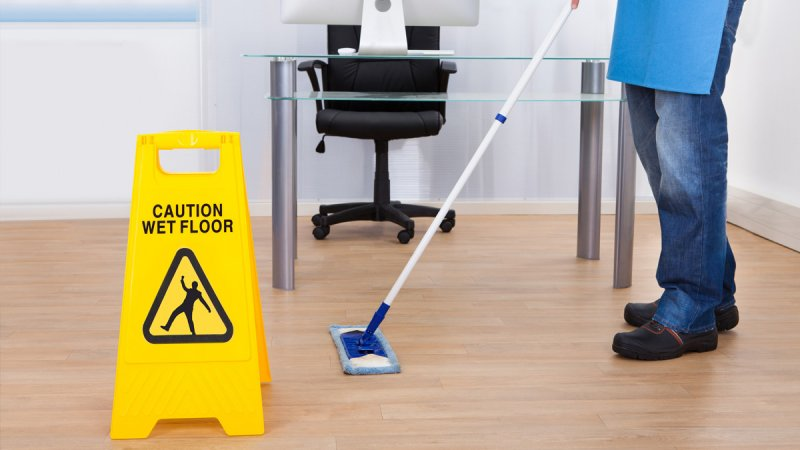Spillages can happen in any workplace. Whether it’s a relatively minor case of somebody dripping some tea in the office kitchen or a large chemical leak that can only be cleaned up with specialist equipment, spillages should be treated with the seriousness they deserve. Slips and trips are the most common causes of workplace injury, resulting in anything from minor bruising to fatalities, but they are almost always highly preventable. Making sure floors are clean and tidy is one way of preventing these incidents.
Many people consider cleaning floors to be a relatively straightforward task they can simply approach with “common sense”. It’s true that the rules for safely cleaning floors are easy to follow once you’re aware of them but a sense of what constitutes common sense varies from person to person, and the same technique won’t work in all cases; for example, using a wet mop for a wet spillage might make the problem worse and simply spread the hazard further across the floor surface.
The people most at risk from a spillage are those cleaning it up, so even for small spills, it’s important to take extra care.
Selecting the Correct Equipment and Techniques
Once a dirty or wet floor is spotted, it’s essential to stop people accessing the area until it is clean and dry. Signs and cones can do this job but might be ignored if the spillage is not obviously visible, so restricting access by locking doors or a similar method is better, if possible.
Consider which substance has been spilled. Is it water or something harmless, or is it a chemical that could cause irritation if it made contact with the skin? Choose the right cleaning materials and make sure you’re using the right amounts. Make sure detergents have enough time to work on greasy floors and use a dry mop or dry vac to leave the surface dry after cleaning.

Making Sure Spills are Reported
Some companies implement a “deal with it” policy towards anyone who spots a spillage. If someone is in the middle of a busy working day, it can sometimes be tempting to leave minor spills or to assume somebody else is dealing with them. Unfortunately, this has led to many workplace slips and injuries.
It won’t always be possible for the person who first spots the spillage to be the one who cleans it up (although staff training can be very useful for letting people know how to deal with smaller spills themselves). However, if staff go into such a situation with a “deal with it” mentality rather than ignoring the problem or assuming someone else will handle it, they’re more likely to notify the person who does need to know, ensuring the cleaning takes place quickly.
The Dangers of Slips and Trips
Making sure floors are cleaned correctly is not just a case of making the workplace look tidy. Falls, slips and trips account for around 31% of all workplace injuries. They are also the most likely type of accident to lead to other types of injuries – for example, a slip leading to a fall from height, or a trip leading to a worker touching a hot surface and getting burned. In one harrowing case, a 16-year-old fast food worker sustained serious burns to her left arm after slipping on water from a leaking ice-making machine and putting her hand into a 360°F oil fryer. The machine had been leaking for several days but the outlet was understaffed and serving customers was prioritised more highly than cleaning up spillages. After a £15,000 fine from the local authority, the employer changed their processes and provided staff with updated training.
Floor cleaning is an important part of an overall culture of good housekeeping. Removing obstructions from walkways and making sure electrical devices don’t leave trailing wires reduce the risk of slips and trips and also reduces a workplace’s fire risk – clutter and below par electrical safety are huge risk factors for workplace fires.








